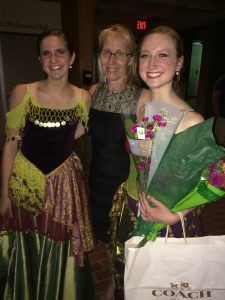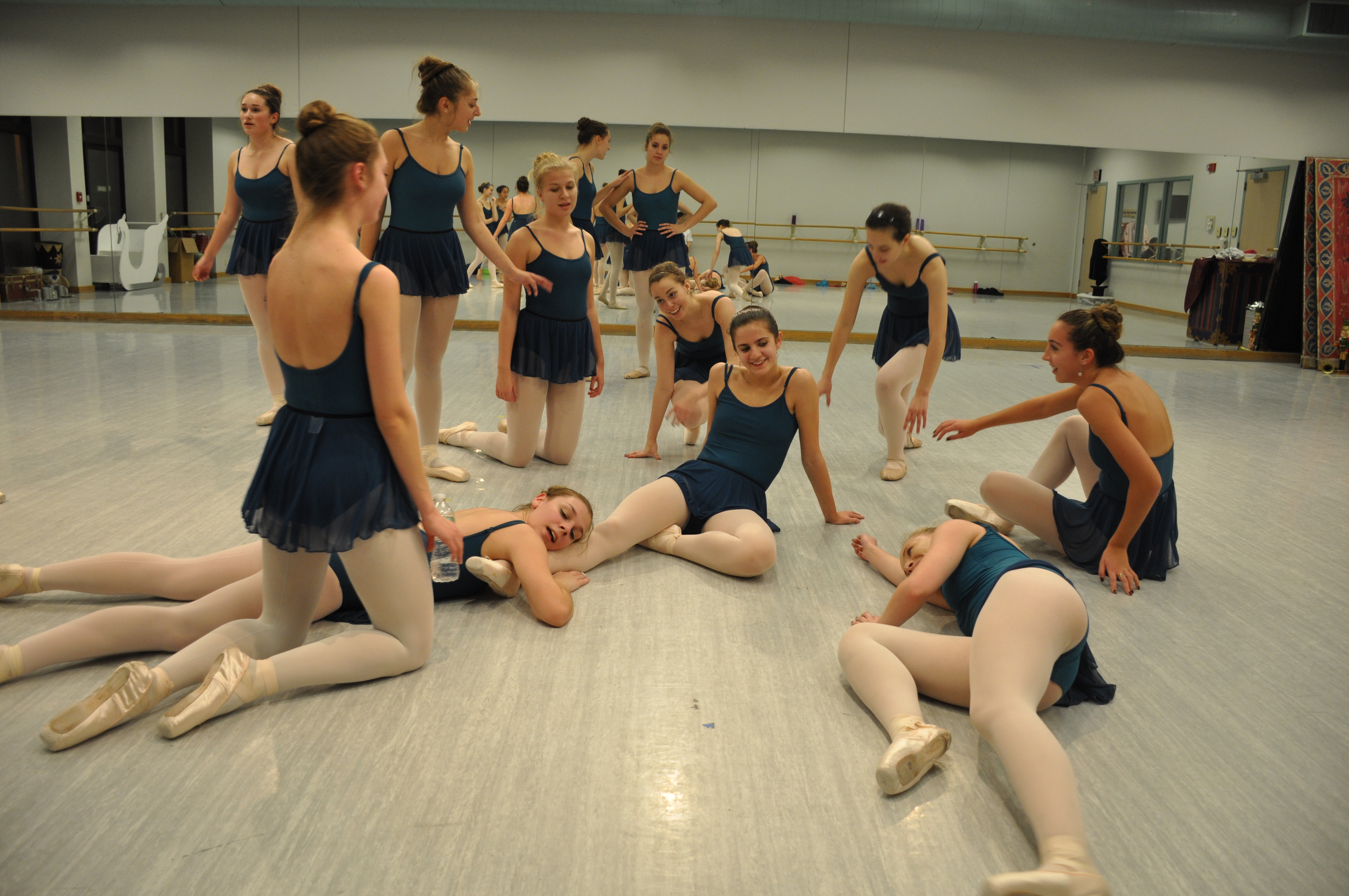I stand in first position with my left hand on the barre. I am sweating already, though we’re only fifteen minutes into class and the hardest work is yet to come. Nancy, my ballet teacher, moves gracefully through a combination at the front of the room, instructing us on flow of the movement, placement of our limbs, direction of our gaze. She is dressed in the same black leggings and long black sweater she always wears. As I watch her, she strikes me as ageless, existing elegantly outside the passage of time; she is in her sixties, but could be much younger with her still-blonde hair, her easy and agile movement. She presses play on the stereo and turns to watch us try the combination—plié, tendu, relevé, repeat. Her eyes move over each of us carefully, collecting. “Balance!” she yells out, when someone’s muscles grow tired and they begin to tip. She does not allow us to give up.
I showed up for my first class at Nancy’s dance studio at age eight, nervous and shy. I had signed up for a tap and jazz class after watching my friend perform in her own dance recital; I wanted to wear tap shoes and move fast to upbeat music like she did. I did not want to do ballet. After a few weeks in the tap and jazz class, however, Nancy reached out to my mom with—from my perspective—tragic news. If I wanted to continue taking my tap and jazz class, I was also going to be required to do ballet. (Many dance studios have this requirement, as ballet provides a strong foundation for other forms of dance.) When my mom first shared the news, I thought about quitting altogether—just weeks after I’d begun. But I already loved my class, and with a little prodding from Nancy, I decided I’d try ballet. Emphasis on try. I never imagined I’d get further than a little bit of trying at the beginning. In photographs from my first ballet recital, I look as though I am falling slowly into a deep pit of despair. I hated ballet.
I might have dropped dance after this first performance. I might have easily returned to all the team sports I’d played before. Nancy, however, sensing my reluctance and resistance, was on a mission to keep me at the studio. She made it entirely clear to me that it would be a mistake to stop dancing, that there was some special quality in my movement or my approach to the art. I believe strongly that her investment in me did not come from a selfish place, from a desire for a higher number of students enrolled at the studio, but rather from a place of deep care. She talked to my mom after class, informing her of the skills I had made progress on that day and her faith in my abilities. She encouraged me directly in class—she pushed me to challenge myself and always made it entirely clear that she knew I could master whatever step or position or combination we were working toward. Somehow Nancy understood—before I did, before my mom did—that there was something in me that needed to move this way. She knew that I could thrive as a dancer, as a ballet dancer specifically.
With Nancy’s direct support, I kept going with ballet. For the first few years, I was hesitant. More often than not, I dreaded going to class. But time passed and passed, I grew and grew, and something began to change. Starting around the age of ten, I found myself looking forward to my ballet classes. I found myself feeling a joy like no other as we leapt and kicked and spun across the floor, and a similar joy when I mastered a skill that weeks or months before seemed impossible to me. I remember shyly admitting to my mom—who’d heard my endless complaints about ballet year after year—that I was starting to love it. Nancy was there by my side through this movement from hatred to love, guiding me along, creating space in which I could grow at the pace I needed. When she sensed that I needed to be challenged, she made it possible for me to move alongside older dancers. She offered me parts in performances that involved new steps and skills. She gave me information about ballet summer intensives, many of which I ended up attending; at these camps, I was able to explore ballet technique more deeply and build relationships with peers who had also fallen in love with the form.
Nancy offered me endless support and countless resources, but one offering of hers—a lesson—sticks out. It was my senior year of high school, and so my last year at the dance studio. For the spring concert, my final performance, I was set to dance a solo. I remember working with Nancy and a few other teachers over the course of multiple rehearsals to learn the steps and perfect the technique. And then I remember one specific rehearsal: I knew the steps, I felt I had mastered the piece technically, and I was performing it in the studio in front of Nancy. I can feel, even now, the way she watched me, with her direct and piercing gaze. After I finished, I expected affirmation, as I was confident about my “correct” completion of the steps. Nancy, however, did not look incredibly pleased. She paused for a moment and then moved closer to me, saying, “Chloe, what does this dance make you feel?” I had no idea how to answer this question—I had not been thinking about emotion at all as I performed. Nancy continued: “I need to see some feeling. Your technique can be beautiful, but it won’t matter if there’s no feeling behind it.”
As a high-schooler, I kept most of my feelings stuck inside. I always struggled to express to other people how I felt. As a dancer, I focused all my energy and attention on being “correct” and on mastering new technical skills. I believed this was what made a good dancer: someone who could do everything right. Nancy saw that I was approaching my senior piece from this state of mind and she did not hesitate to challenge my approach. In that moment—standing, sweaty and tired, across from Nancy in the dance studio—I began to understand the importance of bringing emotion into the learning process, of connecting emotion to knowledge and skill. Perhaps, I began to think, being a good dancer—or even a good person—does not just mean doing everything “right.”
Nancy did not alway do everything right. She was hard on me and even harder on other students. She pushed people in ways they needed—the challenges she presented to me were often incredibly helpful in the long term—but sometimes she did push people too far. She could use hurtful language in class when students were not doing what she expected. She grew stressed very easily, especially around performances, and we all tried to keep a safe distance at these times. She could be explosive and was responsible for a lot of tears. I witnessed this year after year, but I also witnessed Nancy’s owning of her behavior—she often apologized openly to students when she realized she’d said or done the wrong thing. I saw more humanity, more complications, in Nancy than in any other teacher I’d had. She was a full person with a wide range of emotions, a person who made mistakes and apologized. She was an amazing teacher and also at times a terrible one.
I keep learning from Nancy even years after I graduated and left the dance studio. She planted all kinds of seeds that are sprouting and growing in me still, long after we stopped our regular contact. Ballet was incredibly important to me for much of my childhood and adolescence, but the lessons that stuck have nothing to do with ballet technique. Rather, they are lessons that extend far beyond the world of dance. Our conversation about emotion is a conversation that never really ended—I am constantly engaged in that conversation with myself, constantly learning how to be more open and vulnerable. I think frequently about the connection between emotion and knowledge/skill as I work with young students in elementary-school classrooms. Every day, I try to prioritize being human—with all the complications and feelings that brings—above being “right.” Nancy taught me how to do this through conversation and through her own openness with her students.
Nancy had utter faith in me from the beginning, and she never wavered. She made this faith clear through her words and actions, and I am the person I am today in part because Nancy saw potential and promise in me that I could not see in myself. I try to look for the strength, skill, and inner light in all the young people I work with, as well as in my friends, family, colleagues. I truly believe every person has something original and beautiful to offer. I am eternally grateful that Nancy believed this of me.

From left to right: me, Nancy, and one of my closest friends at the dance studio after a performance in my junior year.

Chloe–it was so wonderful to read this tribute to your dance teacher, Nancy. I studied ballet and modern dance growing up, and felt a deep connection to your story. Your portrayal of the hard work, tenacity, grace, dedication, and investment that the dance world requires and teachers encourage is spot on. Thank you for putting this experience into words!